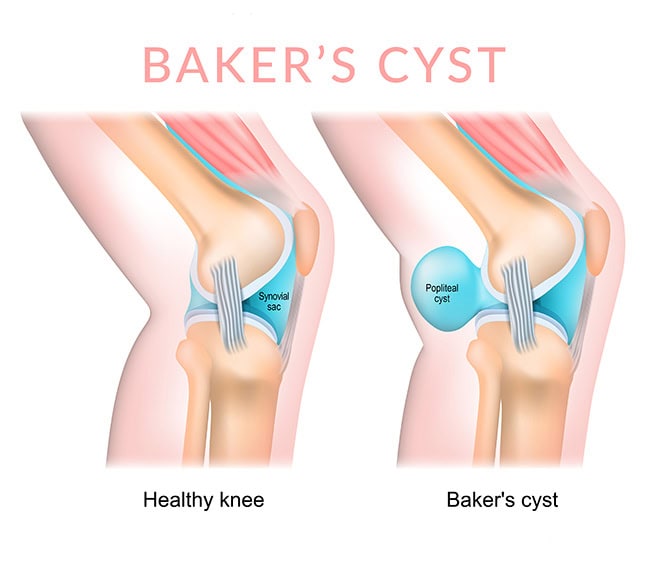

In order to provide safe and effective bodywork, massage therapists have a responsibility to their clientele to be educated on a wide range of conditions. A growing number of consumers seek regular complementary healthcare treatments as a vehicle to remaining healthy. Many rationalize that these visits replace or at least supersede a visit to their allopathic medical doctor. This trend means that massage therapists are likely to be the first healthcare professional seeing a condition requiring a referral. Whether a client comes in with a diagnosed Baker’s cyst, or you recognize it as a possible explanation for a client’s lump, all bodyworkers should have a basic understanding of this condition.
What Is a Baker’s Cyst?
A Baker’s cyst, otherwise known as a popliteal cyst, is a swelling at the back of the knee. According to Ruth Werner, author of A Massage Therapist’s Guide to Pathology:
“Baker’s cysts are pockets of synovial fluid that are suspended from the knee joint capsule or from a bursa on the posterior side of the knee, sometimes they’re called popliteal cysts. They usually protrude into a gap between the medial head of the gastrocnemius and the tendon of the semimembranosus so that’s on the medial aspect of the popliteal fossa…. if it gets really big, it can go down the back of the calf deep to the medial gastrocnemius. These cysts are often small and silent, but they can get big enough to interfere with function, especially range of motion inflection, and they can cause asymmetry in the size and shape of the lower leg, and as I hope you know that is always a situation that demands some questions from massage therapists. One of the interesting factors in Baker’s cysts is that the pouch often has a one-way valve and this allows fluid to flow into it, but not out, and this is why they rarely spontaneously resolve.”
Excessive synovial fluid in the knee can be a result of many types of damage to the knee:
- Injury to the collateral or cruciate ligaments of the knee
- Torn meniscus
- Chondromalacia of the patella
- Osteoarthritis or rheumatoid arthritis
Baker’s cysts are prevalent in about 5% of the adult population but that number is higher in older patients. They tend to be more common in adults ages 35 to 70 and are most often associated with joint disease such as rheumatoid arthritis or osteoarthritis or can occur as a result of knee overuse or injury. For children, Baker’s cysts occur most frequently between 4 and 7 years old.
Symptoms of a Baker’s Cyst
In some cases, a Baker’s cyst causes no pain and goes unnoticed. However, signs and symptoms that may be noticed include:
- Round to oval mass behind the knee, ranging from soft to hard – typically the size of a golf ball
- Knee pain and stiffness
- Tightness in the back of the knee and difficulty bending the joint.
- A sensation of pressure in the back of the joint, which can progress down into the calf muscle
- Knee aching and tenderness after exercise
- When all lights are turned out and a flashlight is directed through the lump, a red glow around the lump is seen. The red glow indicates that the lump is filled with fluid.
Allopathic Treatment for Baker’s Cysts
In order to correct the problem, physicians treating a Baker’s cyst typically search for the underlying cause of the bulge. When severe enough to hamper daily activities, the allopathic medical community approaches Baker’s cysts with both surgical and non-surgical solutions. In general, the more conservative tact (non-surgical) is preferred. Only a person’s physician is qualified to determine if surgery is necessary or if the fluid can be successfully aspirated with a needle. Unfortunately, the more common treatment, needle aspiration, is only a temporary solution. Rest and elevation are crucial to any Baker’s cyst treatment plan.
With the understanding that their intervention merely provides temporary relief, many doctors have their patients work with a physical therapist using massage therapy, compression wraps and electrical stimulation to reduce knee swelling. Flexibility and strengthening exercises for the lower limb are often used to help improve muscle balance in the knee.
Massage Therapy and Baker’s Cysts
Massage therapy can help individuals harboring a Baker’s cyst. By focusing on the probable underlying knee problem, the swelling and discomfort of a Baker’s cyst can typically be relieved. Seeking the cause of an imbalance in the knee can be aided by performing some manual resistive testing to your assessment skills. For more information on these tests, read the article, Eight Tests for Anterior Knee Pain.
Interestingly, popliteal cysts are located in an area contraindicated for most massage techniques. Although it is important for bodyworkers to avoid deep, direct pressure on the cyst, it is still possible to have a significant therapeutic impact. Experts recommend treating the area above the cyst, primarily by addressing the hamstrings and adductors. Balancing the musculature supporting the knee joint compensates for pathological injury or torque contributing to knee dysfunction. Additionally, including lymphatic drainage massage techniques into a session will facilitate absorption of the excessive synovial fluid accumulation, leading to a quicker recovery.
Bodywork Precautions
The presence of a firm protrusion behind the knee should not be assumed by a massage therapist to be an innocuous Baker’s cyst. There is a possibility it could be a tumor or popliteal artery aneurysm, thus necessitating thorough evaluation by a medical doctor.
It is very important for massage therapists to avoid firm pressure directly on the cyst. A Baker’s cyst could become large enough to locally impinge nerves or blood flow, which in the worse case scenario could spawn an embolus. Familiarize yourself with the signs, symptoms and risk factors for a deep vein thrombosis to avoid this potentially devastating scenario. Rarely, a Baker’s cyst bursts and synovial fluid leaks into the calf region, causing sharp pain in the knee, swelling and sometimes redness of the calf. These signs and symptoms closely resemble those of a blood clot in the leg. If a client demonstrates these symptoms, prompt medical evaluation must be sought.
Bodyworkers are regularly presented with all types of pain and physical abnormalities. Some clients will announce they have a Baker’s cyst while others will just ask if you can help reduce the swelling behind their knee. Regardless of the presentation, massage therapists are best prepared to handle these situations when they are properly informed of the condition being presented, understand any danger lurking and are comfortable knowing what they can do to aid in the client’s recovery.














